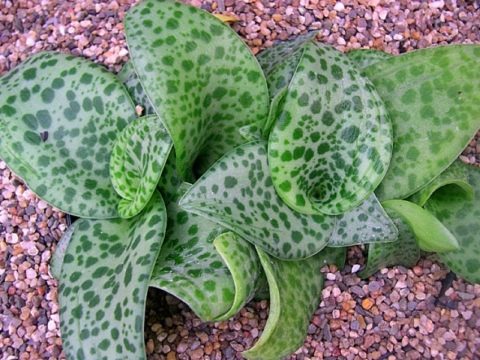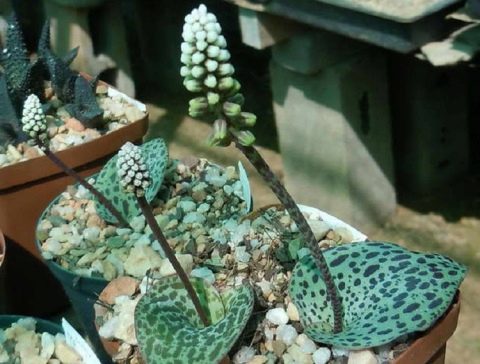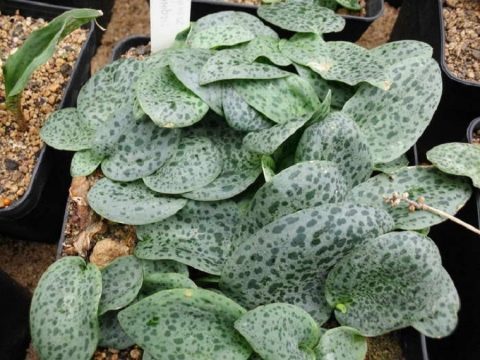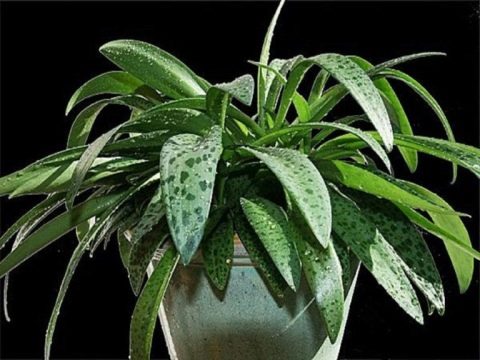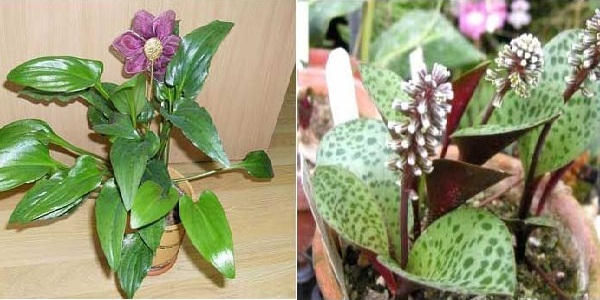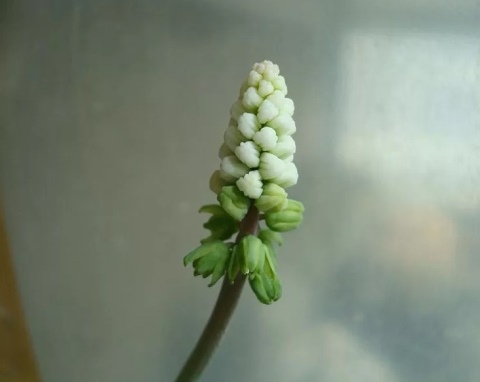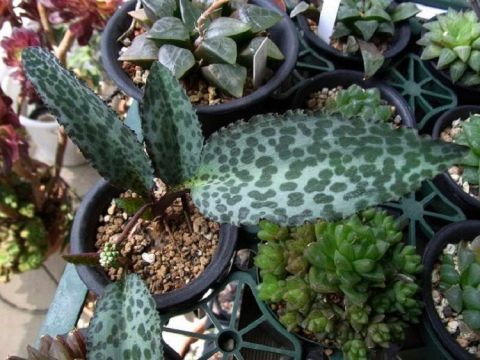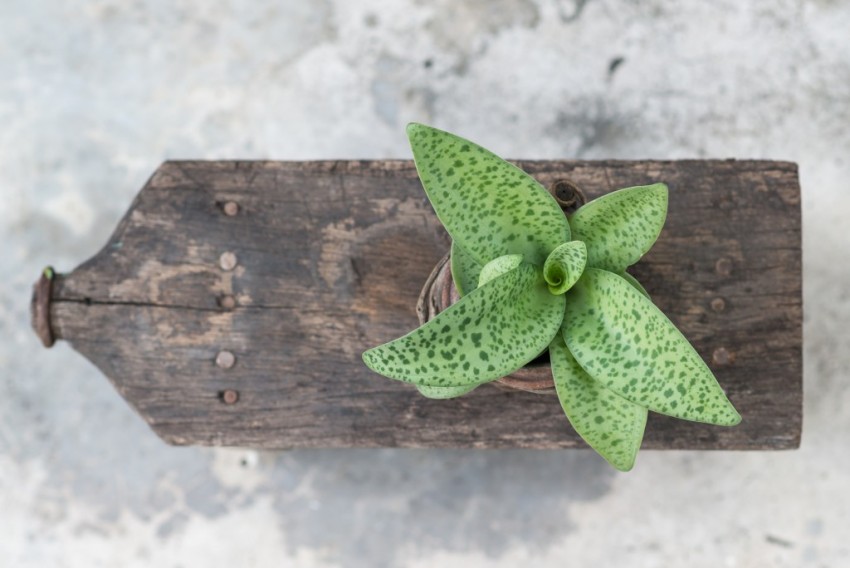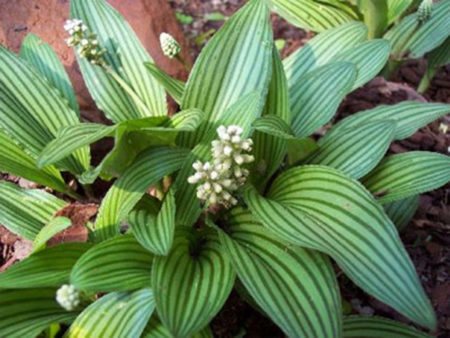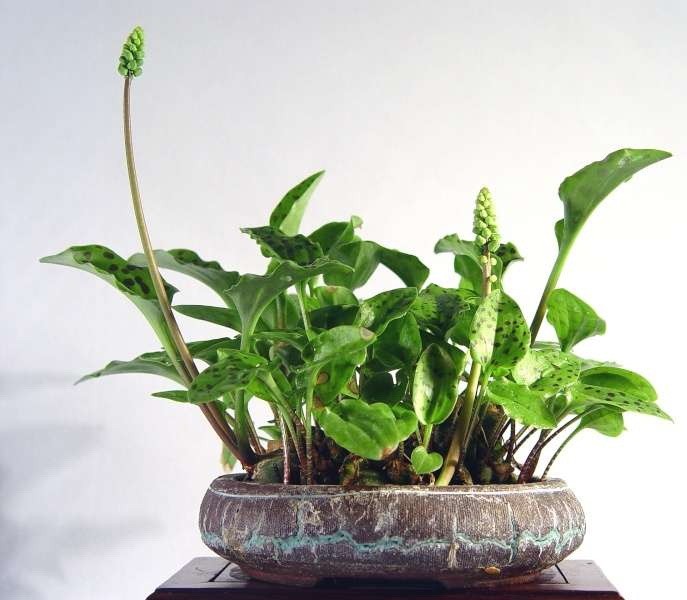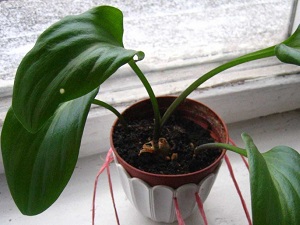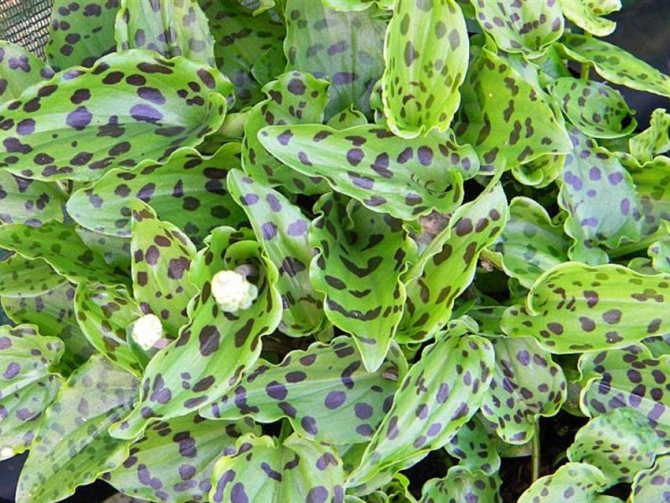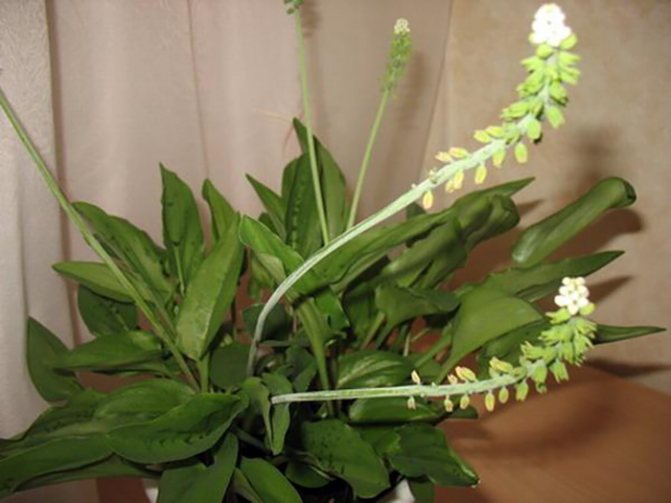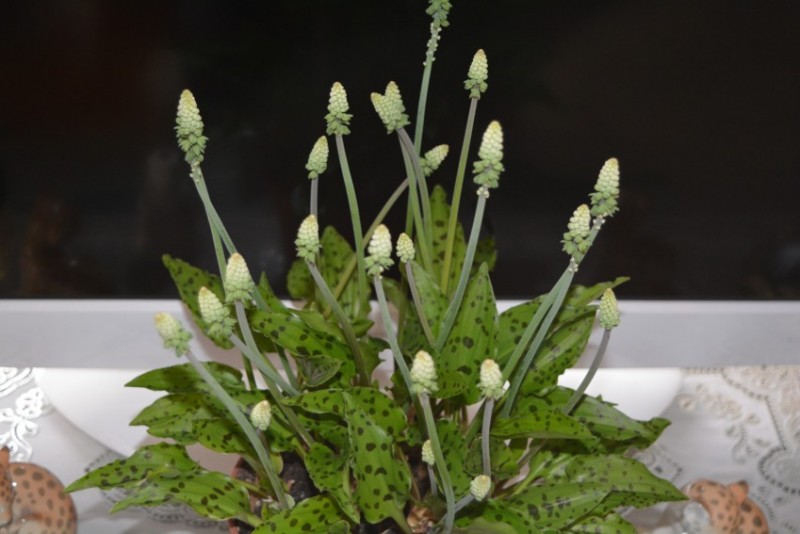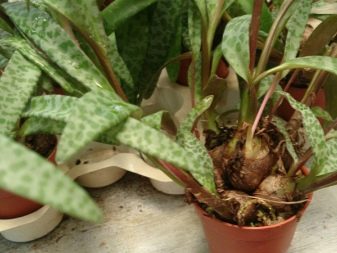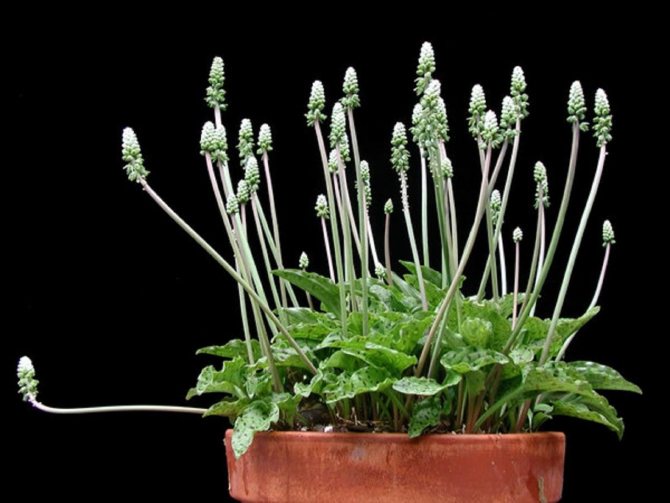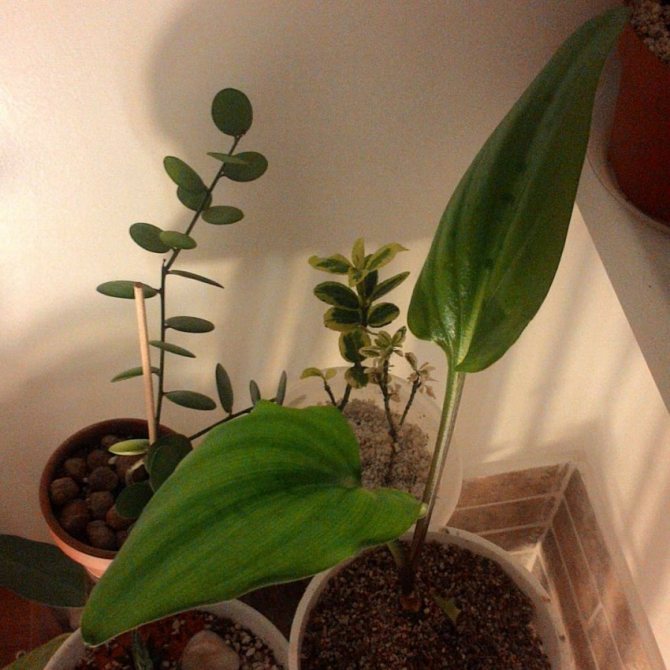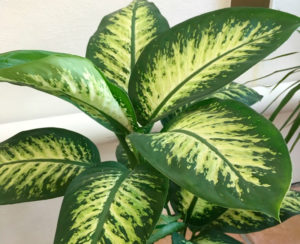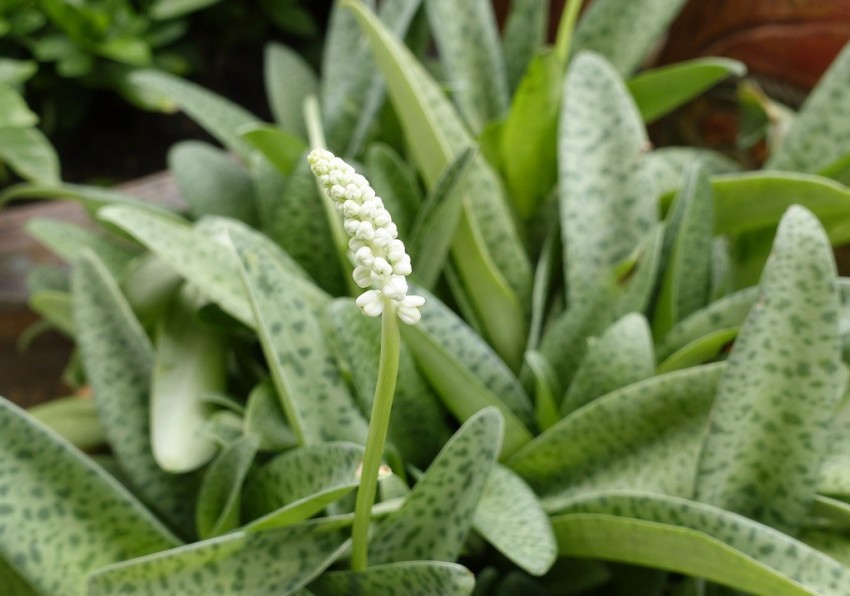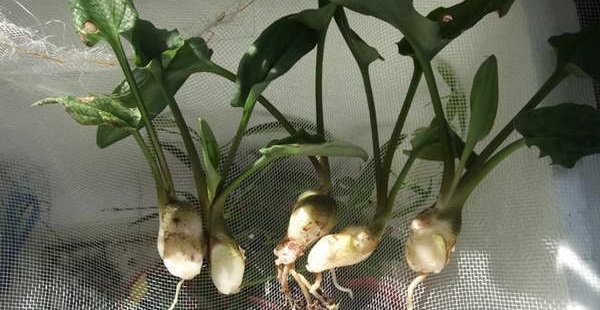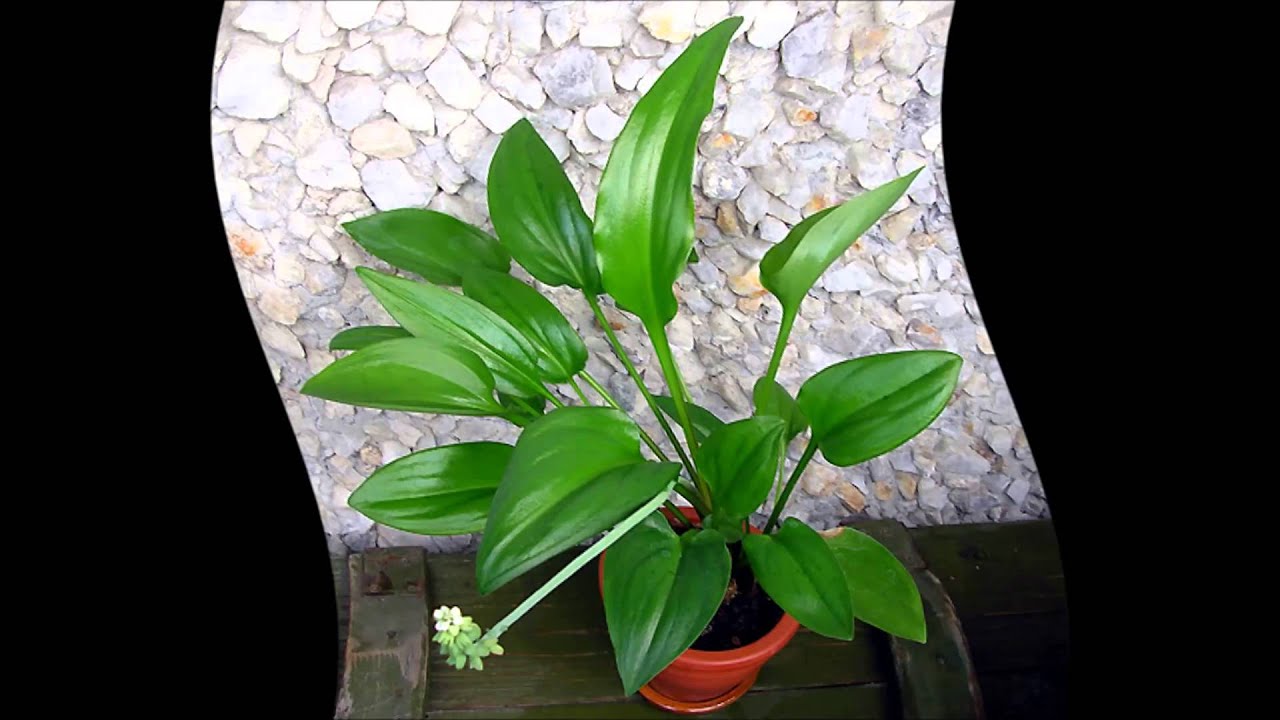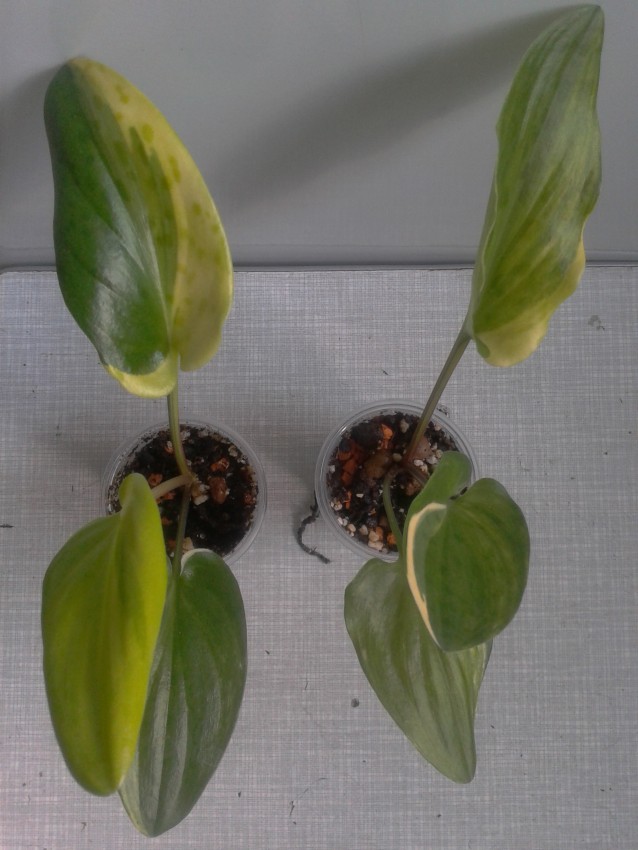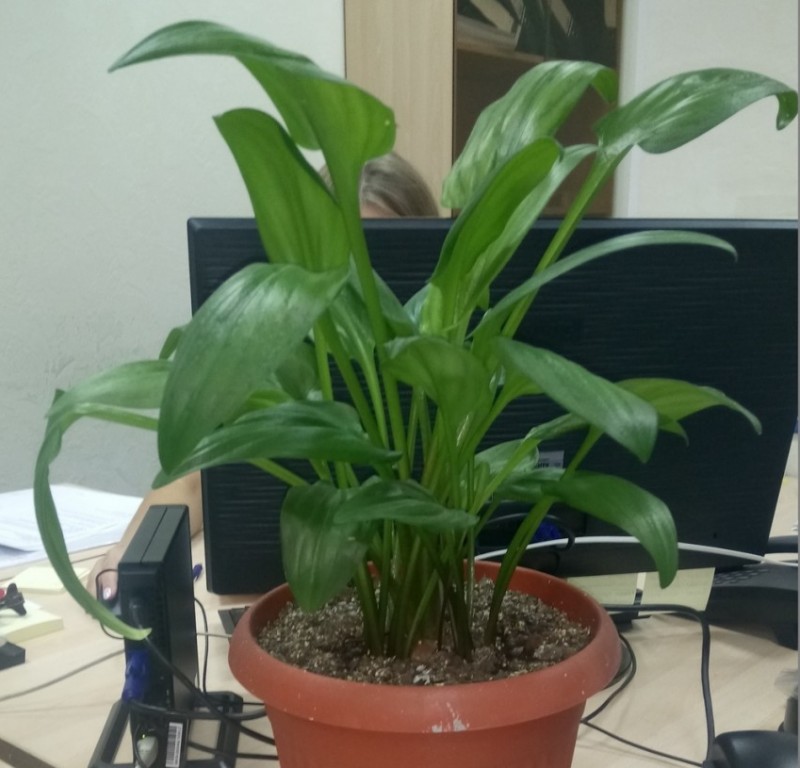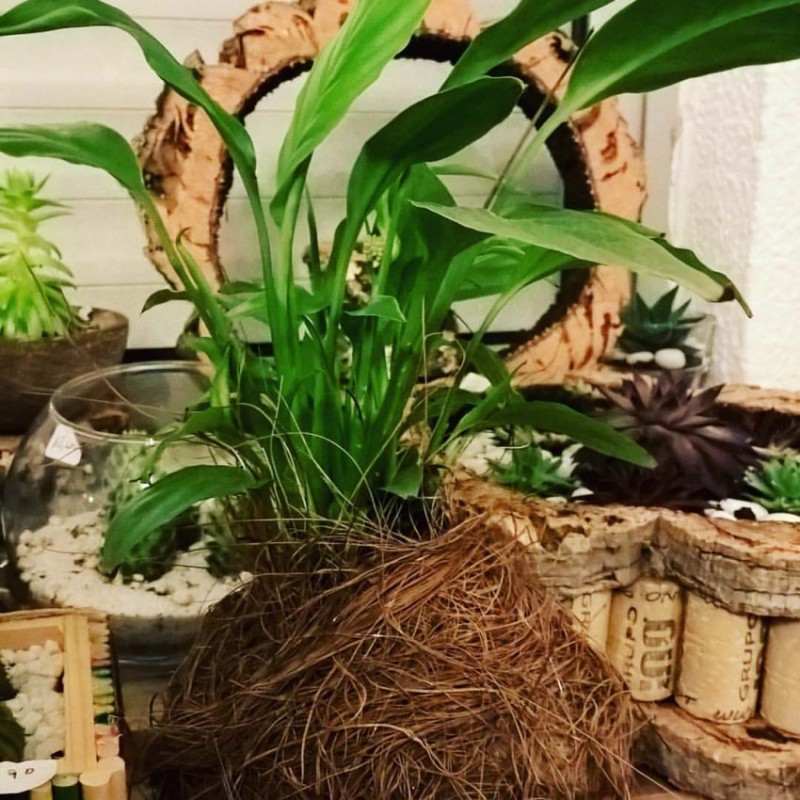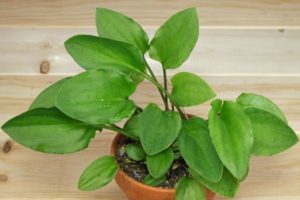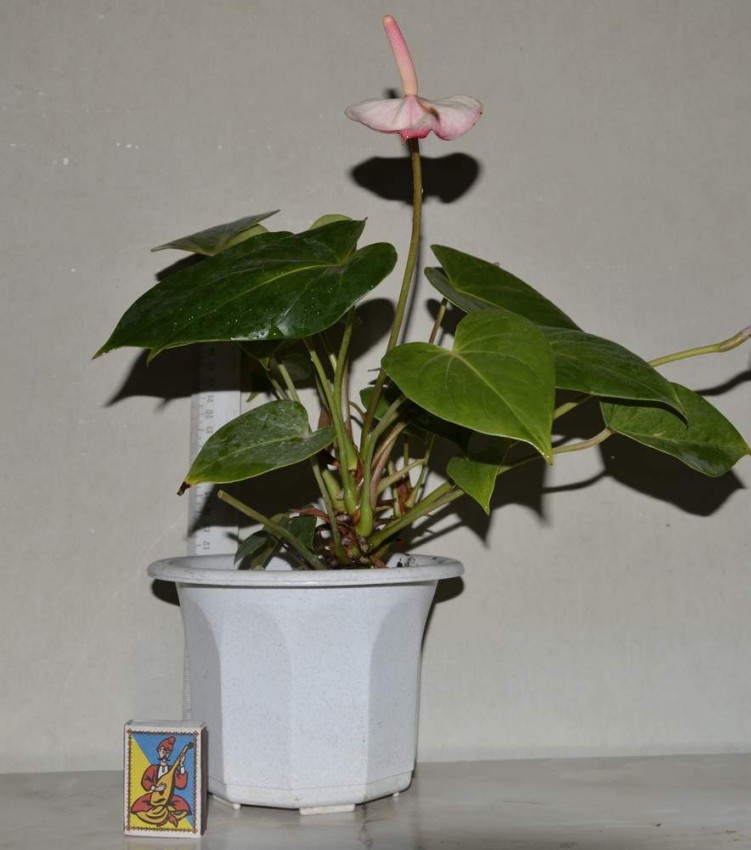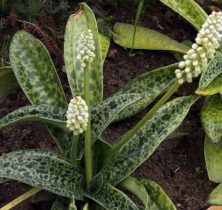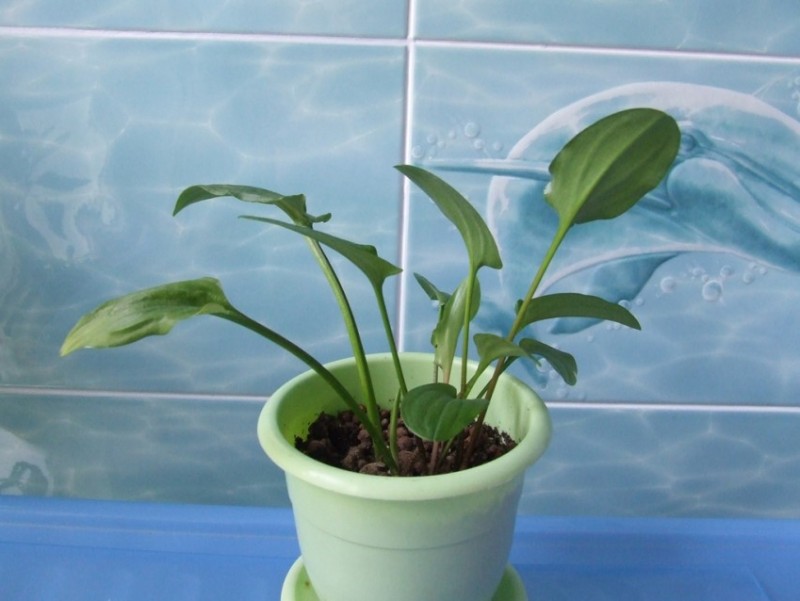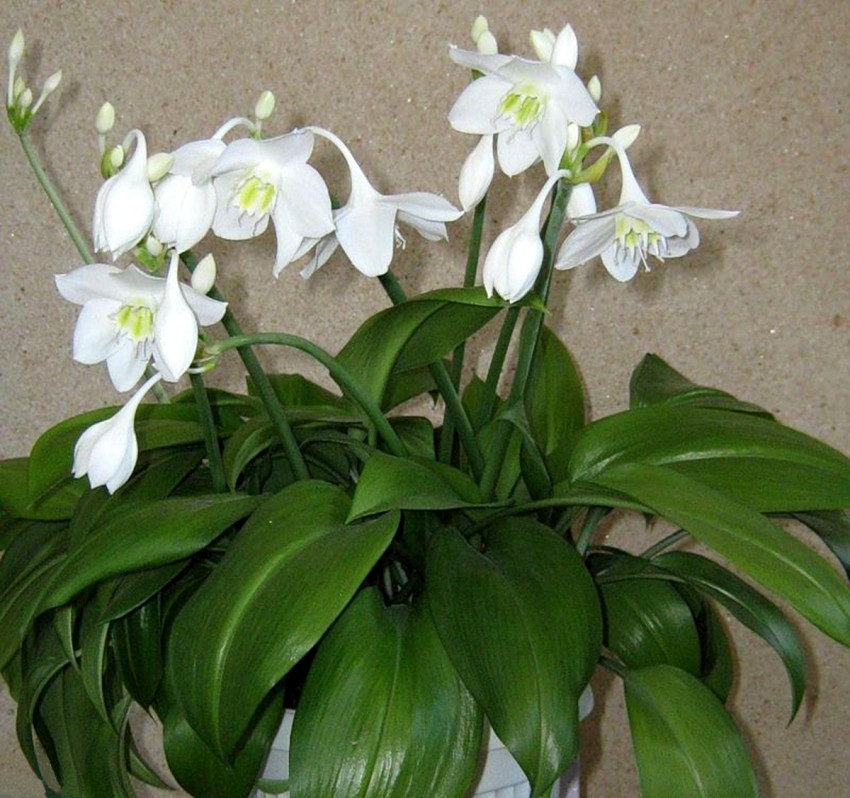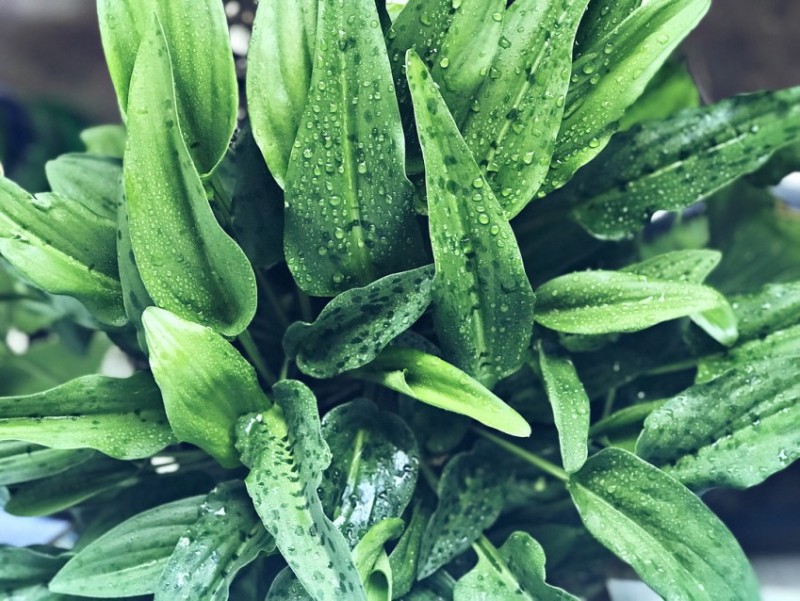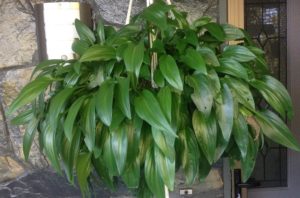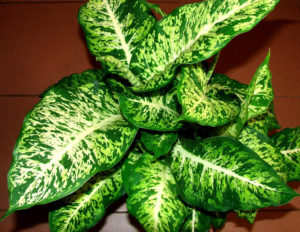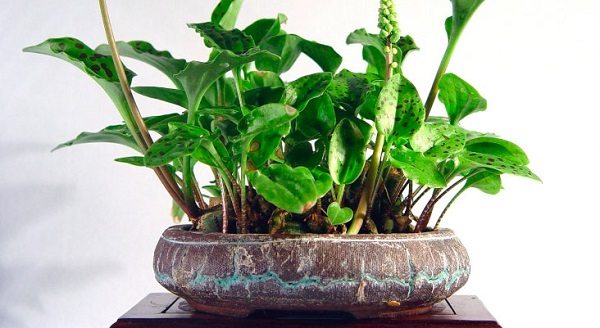Description
The culture belongs to the asparagus family. Drimiopsis also has a second name - ledeburia or scilla, and Africa is the birthplace of the plant. Today, there are about two dozen flower species in nature, while only a few of them can be cultivated in a closed room. The indoor plant stands out for its decorative greenery and flowering, as well as simple agricultural technology.
In harsh climates, it is more correct to cultivate a perennial indoors. Drimiopsis has a developed bulbous root system, and its main part is located just above the ground, which brings some exoticism to the appearance of the flower. The leaves are formed quite low, the green mass is planted on thin petioles, which can reach a length of 10 to 15 centimeters. In this case, the size of the sheet plate, depending on the type, will vary within 12-25 centimeters. In their shape, they can follow the contours of the heart, or they can grow ovoid. Usually, their end is slightly pointed with a smooth surface of the sheet plate. The color of the leaves can be monochromatic, striped or spotted.
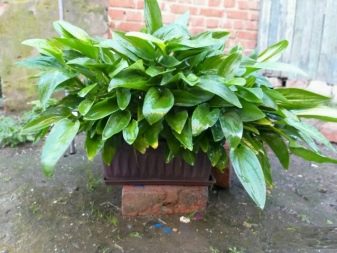
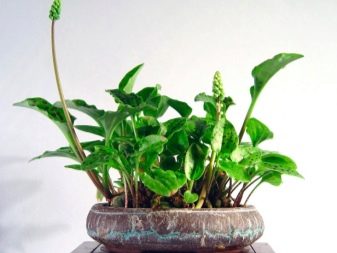
Flowers form on a spike-shaped inflorescence, as a rule, about three dozen buds, painted in white-green color, can be present on one stem. The flowers are not distinguished by their size; on average, the diameter of an open bud does not exceed 5 millimeters. In the flowering phase, the culture gives off a rather subtle floral aroma. In nature, the flowering of Drimiopsis can be observed in the spring or summer months; as for domestic culture, indoor varieties are capable of throwing buds all year round, but provided that in winter some plant species are in a dormant phase.

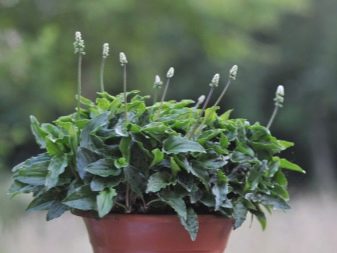
Home care
Drimiopsis is native to the African tropics with a hot climate. However, the plant has perfectly mastered in apartment conditions, far from the natural conditions of Africa.
Illumination
Decorative spots on the leaves appear when the plant is provided with bright diffused light. Drimiopsis is able to calmly stay in direct sunlight, but it is better to create a light shade for him in the hot summer to avoid burns. It is undesirable to use only artificial light for growing a flower.
The plant should be placed on the windowsills of windows facing the south, southeast or southwest side. In the summertime, it can be displayed on the veranda or balcony.
Important. The room with a flower must be constantly ventilated, but drafts must be avoided
Temperature regime
The boundaries of the temperature regime in Drimiopsis are extensive:
- during the rest period - moderate 12-16 ° C;
- during the growing season - 20-25 ° C.
The plant is able to withstand temperatures above 30 ° C, but with difficulty.
Humidity
The moisture conditions for the plant are not important. With moderate watering, it adapts to dry air. Spraying with water and wiping the leaves is carried out only in hot weather or to remove dust.
How to water a flower?
Plants are watered when the substrate dries up to a depth of 3-4 cm from mid-spring to late September. In warm weather, watered once a week. Watering is done with soft water heated to room temperature. A great option is rain or melt water. The water should be poured over the edges of the pot, avoiding dripping on the bulbs. Drimiopsis turns yellow from frequent drying out of the soil, but it tolerates dryness more easily than abundant moisture.
Important. Frequent and abundant watering leads to the death of the plant
Top dressing
Drimiopsis is fed with nutrients only during the active growing season.For feeding, choose liquid fertilizers in the form of a solution, suitable for bulbous plants or cacti / succulents. They are fed once every two weeks.
Earth mixture
For growing Drimiopsis, the pot is filled with nutritious soil, light and loose. You can cook it at home by choosing one of three options:
- a mixture of universal soil, peat chips, coarse river sand (ratio 3: 2: 1);
- a mixture of universal soil for ornamental plants, river sand, vermiculite or perlite (ratio 2: 1);
- a mixture of fertile turf, leafy soil, coarse river sand, humus plus charcoal in small pieces.
Transplant features
Drimiopsis up to 3 years of age is transplanted annually. In this case, the diameter of the new pot should be 3-4 cm larger than the previous one. Bulbs aged 3 to 5 years are transplanted every 2 years, after 5 years of age, a growing bulb with offspring is transplanted every 3-4 years.
Important. Drimiopsis is transplanted in the beginning or middle of spring
Instructions for transplanting Drimiopsis will not cause difficulties even for a novice florist:
- A layer of 3 cm is poured into the pot from a mixture of kermazite, crushed charcoal, river coarse sand or brick chips. Then place the freshly prepared substrate on 3/4 of the pot and water it moderately.
- The plant is removed from an old pot, shaken off the ground. The offspring are carefully separated.
- They clean the bulbs from dry, rotten scales and roots; apply greenery, chalk, wood ash to the sections.
- They make a deepening in the soil, place the bulbs in it with a half deepening.
- Compact the soil near the transplanted bulbs, watered moderately.
The process of transplanting Drimiopsis is clearly shown in the video:
Main types
Drimiopsis is an East African bulbous plant, the second name of which is "ludeburia". This genus belongs to the Asparagus family, the Hyacinth subfamily.

Drimiopsis has a unique leaf color
The height of the flower reaches 10-50 cm, depending on the growing conditions and variety. It has elongated long leaves with a pointed end, forming a dense, but compact bush. The color of the leaves can be either monochromatic rich green or spotted.
This plant blooms inconspicuously - brushes of small flowers of a light shade are formed on the peduncles. The flowering looks, though not bright, but unusual.
Pay attention! "Drimiopsis" means "similar to drimia", that is, the so-called sea bow. The biological name of this flower is Ledeburia, in honor of the explorer Karl Frindich von Ledebour
The biological name of this flower is Ledeburia, in honor of the explorer Karl Frindich von Ledebour.
A brief description of the main types of Drimiopsis:
- Drimiopsis Kirk (Butrioid). It has tough, smooth lanceolate green leaves with spots of a grayish or darker shade. They can reach a length of 40 cm, while the petioles are short. At the base of the flower is a white rounded bulb. Peduncles 20-40 cm long, there are few flowers on them, painted in a milky or white color;
- Drimiopsis Spotted (Maculata). The leaves are wide, oval in shape (up to 12 cm high, up to 7 cm wide), located on long (up to 15 cm) petioles. The edges of the leaves are slightly corrugated, with many large dark specks scattered on a light green background. The spots become less noticeable in the fall and brighter in the spring. The clusters of the inflorescences are pale yellow, cream, white or gray. During the dormant period, the flower sheds part of the foliage;
- Drimiopsis Striped (Variegated). In appearance, it looks like a drimiopsis pickaxe, but instead of spots it has dark longitudinal stripes on the leaves. It multiplies and grows quickly in almost any conditions, which makes this species attractive for growing at home;
- Drimiopsis Purple. It has wide, fine-wavy leaves along the edges with pronounced dark spots on the surface and a pointed end.Differs in a purple shade of petioles at the base of the leaves, for which it got its name;
- Drimiopsis Dolomiticus. It stands out against the background of other species by its diminutiveness - small heart-shaped leaves with a spotted color do not have petioles, they are located close to the ground. During flowering, the leaves wrap around the peduncles, at the end of which a brush of light flowers blooms. Separated from each other flower stalks with leaves look unusual and beautiful.

This species can be a great gift for a lover of unusual plants.
Most often, amateur flower growers have Kirk's and Spotted drimiopsis. Care inhome conditions for them is simple, while the varieties have good decorative effect.
Additional Information! Ledeburia bloom at home can last almost all year, with the exception of the dormant period.
Peduncles with tassels at the ends do not look bright, but unusual
How to take care of Drimiopsis at home?
Drimiopsis is increasing its leaf mass.
Caring for Drimiopsis is not difficult, the flower itself is very unpretentious, but very unusual, due to which it received a special love of flower growers.
Where to put Drimiopsis. Correct lighting and location.
Drimiopsis leaf spot depends on lighting.
Drimiopsis is not too picky about lighting, it can be placed deep into the room. However, its appearance depends on the lighting. With insufficient light, the leaf spot disappears and its decorative properties are lost. Drimiopsis requires a bright, but diffused light. That is why, the ideal location for him is the south or east window.
Important! Direct sunlight can damage the plant in the form of sunburn. Be sure to shade the plant at lunchtime!
How to water Drimiopsis. Spraying and air humidity.
Drimiopsis responds positively to spraying once a week.
Watering Drimiopsis must be done carefully to avoid rotting of the bulbs. The earthen lump should have time to dry out at least 2-3 centimeters in depth
After that, you can water it again. During the growing season and flowering, you need to water Drimiopsis 2 times a week. In the autumn-winter period, watering is reduced, and carried out every 2 weeks, making sure that the earthen lump does not dry out too much. Dry and moist air are equally suitable for Drimiopsis. However, he responds positively to spraying once a week. You can also wipe the leaves with a damp cloth to remove dust.
Temperature regime for Drimiopsis.
Drimiopsis is not picky about a special temperature regime.
Not picky about special temperature conditions. In summer, the optimal temperature for it is 20-25 degrees, and in winter it is lower (if possible), but not lower than 15 degrees.
Soil requirement for Drimiopsis. Transplant and fertilization.
For looseness, perlite can be added to the soil for Drimiopsis.
The soil for Drimiopsis is suitable for ordinary bulbous plants. The main requirement is that the soil must be loose. To do this, you can add perlite to the finished soil in a 2: 1 ratio. If you wish, you can prepare the soil yourself. In this case, you will need - sod land, leafy soil, peat and coarse sand. All this must be mixed in a 1: 1: 1: 1 ratio. The container should be chosen rather wide than deep with holes in the bottom.
Important! The use of drainage is a prerequisite for preventing bulb rot.
How to propagate Drimiopsis Kirk?
Drimiopsis of the trigger is propagated by leaves.
Drimiopsis Kirk can be propagated by leaves. It is necessary to carefully remove the leaf from the bulb along with the stem. Place this leaf in water or peat with perlite. In addition, the fleshy leaves can be cut into plates 5-6 centimeters long and also placed in peat - each shoot must take root.
Drimiopsis leaves grow bulbs.
Video - how does Drimiopsis spotted reproduce?
Drimiopsis spotted propagates by seeds or by dividing the bulbs. At home, the second method is most often used. When transplanting the mother plant in the spring, it is necessary to separate the daughter bulbs that have grown, and plant them in a separate pot.
Drimiopsis care at home
How to grow Drimiopsis at home
To maintain decorativeness at a high level, drimiopsis requires bright diffused light. The plant tolerates direct sunlight well, but in the summer in the afternoon it needs shading.
During the period of active growth, the optimal temperature in the room should be about 25 ˚C, but in the winter, the resting plant needs coolness, that is, the temperature does not exceed 15 ˚C.
In order for the crown of Drimiopsis to develop symmetrically, the pot with the plant is rotated once a week around the axis by a third of a turn.
Watering and feeding Drimiopsis
From spring to autumn, that is, during the growing season, watering ledeburia is carried out regularly as the upper layer of the substrate dries
In autumn, watering is reduced, and in winter, a plant resting in a cool room is watered occasionally and very carefully. The principle of watering remains the same: the substrate is moistened as soon as it dries to a depth of 3-4 cm
Air humidity for Ledeburia does not play a significant role, therefore, wiping the leaves with a damp sponge is primarily hygienic.
In the photo: Growing Drimiopsis in a pot
During the growing season, the Drimiopsis flower is fed with solutions of mineral complexes for bulbous plants or for cacti twice a month. In winter, drimiopsis do not need feeding.
Drimiopsis transplant
Young drymiopsis are transplanted annually, adults - as the bulbs grow, but not more often than once every two years. When and how to transplant Drimiopsis from an old pot to a new one? The plant is transplanted at the end of the dormant period when it prepares for the new growing season. The bulbs are planted in wide pots so that they have somewhere to grow with children. The plant needs a substrate that is loose, nutritious, consisting, for example, of equal parts of humus, sod, leafy soil and coarse sand with a small amount of charcoal. A layer of drainage material is placed in a new pot, then drimiopsis is transferred onto it, after which the space is filled with a substrate. After transplanting, the plant is watered and not fertilized for at least a month.
Drimiopsis reproduction
It is possible to grow drymiopsis from seeds, but this difficult process takes a long time. It is much easier to propagate the plant with children, separating them from the mother bulb during transplantation, especially since the young bulbs literally push the mother bulb to the surface, where it can no longer form any inflorescences or leaves. Places of cuts or breaks must be sprinkled with coal powder for disinfection, after which the children are planted in separate containers with a substrate for an adult plant.
Indoor Drimiopsis Kirk can also be propagated by leaf cuttings: the leaf of the plant is cut into pieces about 6 cm long, then the cuttings are planted in wet sand, covered with a transparent cap and kept at a temperature of about 22 ˚C. When the cuttings are rooted, they are seated in separate containers with a diameter of 7 cm, filled with a loose, moisture-permeable substrate.
Drimiopsis care at home
High-quality care for Drimiopsis is the basis for its favorable development and the normal functioning of vital systems
First of all, pay attention to what container you choose for planting a plant. It should not be deep, but wide
During the season, Drimiopsis at home quickly gains mass and can acquire several daughter bulbs.The pot should not be cramped for the root tuber, since in places where it will come into contact with the walls of the pots, rot may form and the perennial will die. The bulb grows very quickly during the growing season - this must be taken into account when planting and replanting.
The air temperature for keeping a tropical guest at home ranges from 15 to 25 degrees Celsius. In winter, a decrease to +20 is permissible. A perennial dies even with a short-term drop in temperature below +8 degrees. When ventilating the room, avoid exposing Drimiopsis to cold wind and drafts.
Frequent transplants are not needed for Drimiopsis. This procedure is recommended to be carried out no more than 1 time in 2-3 years. If you abuse the transplant and do it annually, then the perennial stops blooming. Liquid formulations for flowering plants are used as fertilizer. Complex feeding is suitable for bulbous or cactus indoor crops.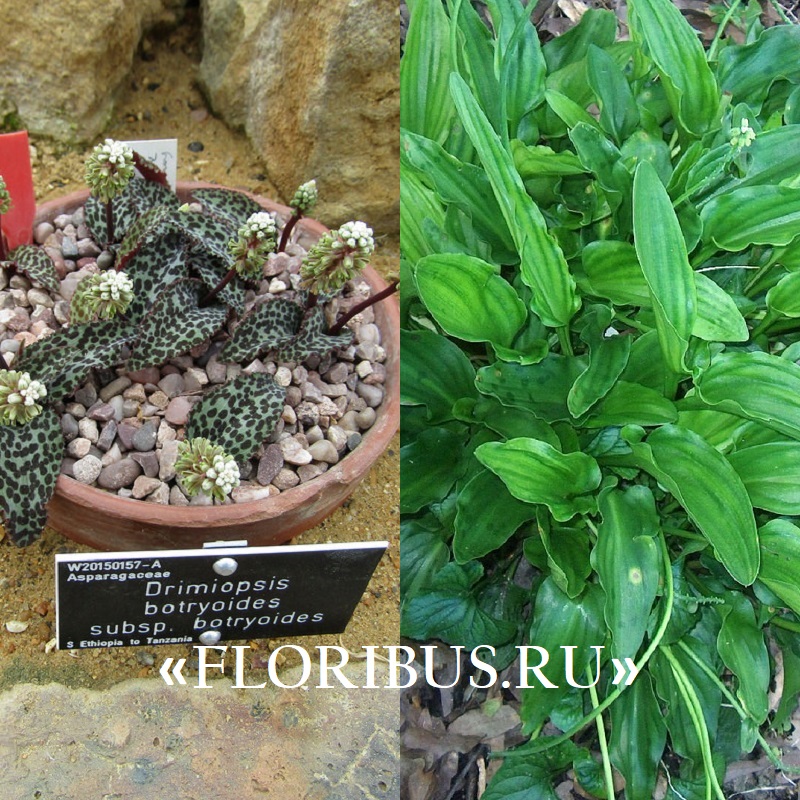
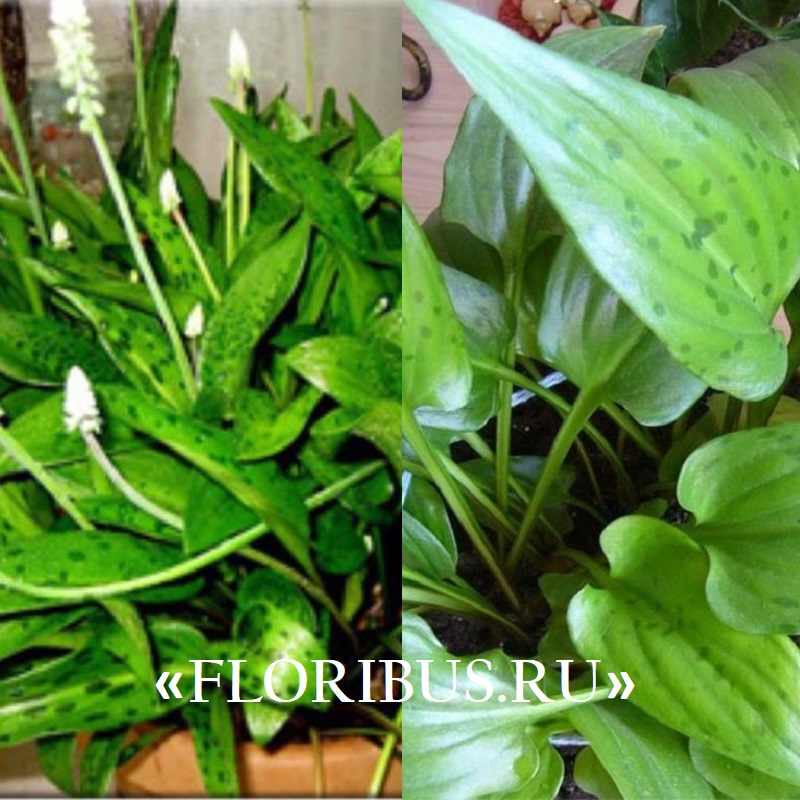
Home care
Drimiopsis belongs to unpretentious houseplants. For normal development, he needs very little.
Location and lighting
Ledeburia requires a well-lit area, but without direct sunlight. Windows of the east and southwest direction will do. To avoid sunburn through the glass, during the period of solar activity, you need to shade the plant or remove it deep into the room.
But if Drimiopsis grows in the summer on an unglazed balcony or loggia, then sunlight is safe for it. In a shady place, the leaves of the plant begin to fade, the stems stretch out and droop. The variegated color of the leaves can become monochromatic
Choosing a flowerpot
The root system of Drimiopsis is superficial. Therefore, a shallow but wide pot is suitable for planting it. In it, the plant should freely grow baby bulbs. The pot should be well-drained, with holes in the bottom.
Priming
You need to plant the plant in a loose, nutritious substrate. You can buy a special mixture for bulbous crops. It is moisture permeable. Bulbs can rot in dense soil.
You can prepare an earthen mixture yourself:
- turf (1);
- humus (1);
- small pebbles or sand (2).
To avoid further acidification of the soil, and the development of fungal diseases, you can add a little charcoal and vermiculite to it. Lay a thick layer of drainage (expanded clay, broken brick) at the bottom of the pot.
Planting and transplanting
Plants under 3 years old must be replanted annually. Older specimens - once every 2 years. Each time you need to take a pot 2-3 cm larger than the previous one. It is better to carry out the procedure in the middle of spring.
Algorithm of actions:
- Put drainage mixed with charcoal and coarse sand at least 3 cm thick on the bottom of the pot.
- Pour fresh soil on top, filling ¾ of the container volume. Moisten it a little.
- Remove drymiopsis from the old pot, shake the soil from the bulbs.
- Separate the offspring neatly. Remove dry damaged scales and roots. Decontaminate the cut sites with ash or soak the bulbs in a solution of potassium permanganate.
- Allow the bulb to dry. Make a depression in the soil and place the onion there about ½ or a little more.
- Water the soil around the plant and place it in its permanent location. The next watering can be done only after a week.
For greater bushiness, it is possible to plant several bulbs at once in one pot at a distance of 2-3 cm.
Visual video - instructions for transplanting Drimiopsis:
Temperature
Optimal conditions for drimiopsis are + 22..25 ° C, in winter - + 13..14 ° C, but it is advisable not to exceed the temperature of + 20 ° C
For a plant during a dormant period, it is not so much a decrease in temperature as a decrease in the frequency of watering. The critical point is considered to be a temperature of + 8 ° C.
In this case, drimiopsis may die.
Watering and humidity
During the growing season, the crop is watered as needed. The soil should not be allowed to dry out.Too often and abundantly, Drimiopsis should not be watered either. This will cause the bulbs to rot. In the autumn-winter period, the number of watering is reduced, but care must be taken that the earthen lump does not dry out completely.
The plant is unpretentious to air humidity. It is enough for it to be at the level of 40-50%. It is not necessary to additionally moisten the culture. But periodically, you can wipe the leaves with a damp cloth, removing dust.
Flowering period
In nature, Drimiopsis blooms in spring or summer. Indoors, with proper care, you can achieve almost year-round flowering, except for a dormant period. The flowers of the plant are small, collected in racemose or spike-shaped inflorescences. Their shade can be cream, greenish-white. 10-30 flowers bloom in one inflorescence. They bloom gradually, from bottom to top, filling the air with a pleasant aroma similar to lily of the valley.
Top dressing and fertilizers
So that the leaves do not lose their colorfulness, drimiopsis needs top dressing. During the period of active growth, liquid formulations for bulbous crops are introduced 2 times a month. You can take ready-made fertilizers for cacti. You can make top dressing after watering. In winter, you do not need to fertilize the plant.
Reproduction
The described plant reproduces in three ways - bulbs, seeds and leaves. The first method is most often used, since it is the simplest and most effective.
Dividing the bulbs
Drimiopsis bulbs are propagated in the spring at the end of the dormant period, during planting or transplanting a flower. For this, the bulbs are separated from the mother plant, and the cut sites are treated with wood or crushed activated carbon. New bulbs are planted in special bulb soil.
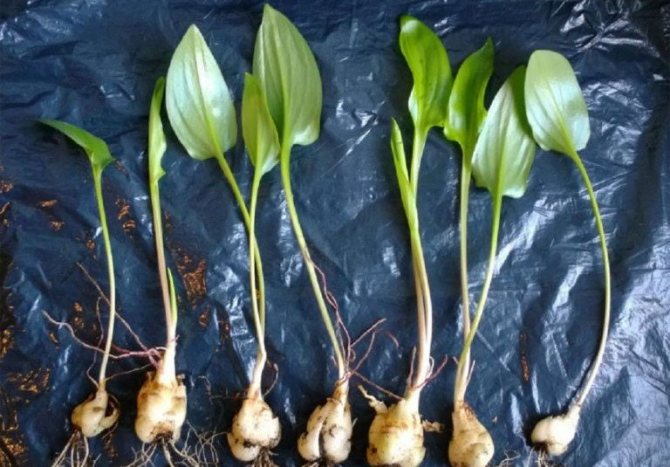
Growing from seeds
This tropical plant very rarely forms seeds in the home, so this method is practically not used. However, if you get seeds of Drimiopsis, then you should sow them in a container with light, well-moistened soil and cover with a film, and then place them in a warm (about + 25 ° C) and bright room.
Seedlings should appear within 15–20 days. After seed germination, the film should be removed, and the seedlings will need to be watered regularly.
Did you know? Some indoor flowers are very useful for insomnia sufferers as they help them fall asleep. These include, for example, aloe: if you put it on your bedroom window, the plant will promote sound and healthy sleep.
Leaf propagation
This method is used mainly for Kirk's Drimiopsis. A healthy leaf of the plant is separated at the base and rooted in a mixture of peat and perlite, or placed in water. You can also use a clean knife to divide the leaf into 5–6 cm pieces and plant them in a mixture of sand and turf. Germination should take place in a warm, well-lit, draft-free environment.
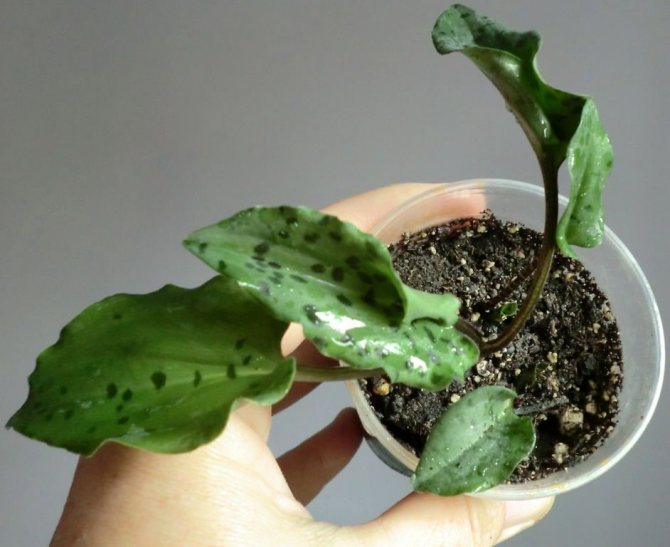
Features of home care
When Drimiopsis is grown, home care does not cause problems even for novice florists, since it belongs to unpretentious varieties. It is required to take care of the flower regularly, but at the same time it is not necessary to perform any complex actions requiring financial investments.
Temperature
For Leburia, the optimum temperature is between 22 and 25 ° C. In winter, it drops to 14 ° C. At the same time, experts do not recommend increasing the temperature values above 20 ° C in winter, and 8 ° C is considered critical. If the indicators fall, lower, then there is a high probability that the plant will subsequently not be able to recover.
Lighting
When growing Drimiopsis, care must necessarily mean providing good lighting. A lighted place is ideal for a flower, but at the same time it should not be kept under the scorching sun. It should never be exposed to direct sunlight, resulting in burns. To prevent their appearance during strong solar activity, it is recommended to shade the flower.
Watering
Water the plant as needed during the growing season. It is strictly forbidden to allow the soil to dry out, but abundant watering can adversely affect the flower and its properties, so it should be moderate.
Humidity
The plant can be sprayed no more than once a week or wipe its leaves with a damp cloth.
The plant is unpretentious to moisture. The optimal indicator is considered to be in the range from 40 to 50%.
Priming
Drimiopsis thrives on loose and nutritious soil. For planting, you can purchase a ready-made mixture for bulbous crops or prepare it yourself. To do this, you need to take turf, humus, small pebbles and sand.
Note! You can prevent soil acidification and the development of fungal diseases by adding vermiculite and charcoal to the soil.
Top dressing
Throughout the entire cultivation of indoor Drimiopsis, in order to make its leaves colorful, it is necessary to systematically feed. Liquid formulations should be applied twice a month during the period of active growth.
Main types
There are quite a lot of Drimiopsis species known - 22, of which 14 species have been studied and registered by science. However, only two are suitable for home conditions.
Pickaxe (Drimiopsis kirkii)
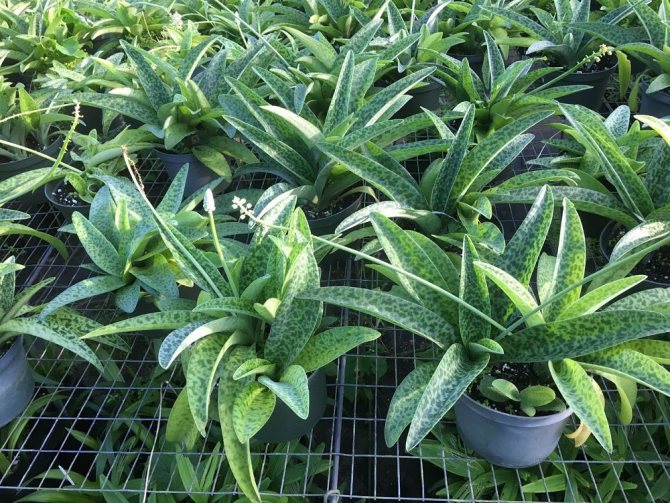
Drimiopsis Kirk has a second name - side-shaped ledeburgia. It grows up to 40-50 cm. It has a rounded onion, similar to regular peeled onions. Leathery leaves with embossed veins have the shape of a lancet, 40 cm long and 5 cm wide, smoothly tapering from center to beginning and tip. Above, a leaf plate of a bright salad shade is decorated with dark green-brown spots, below the leaf has a grayish color. Very short petioles.
The flower stalk is approximately 30 cm high. In natural conditions, the flowering period begins from mid-spring to early autumn. It blooms with pinkish-white flowers. New leaves do not form during dormancy, and old leaves do not fall off.
Spotted (Drimiopsis maculata)
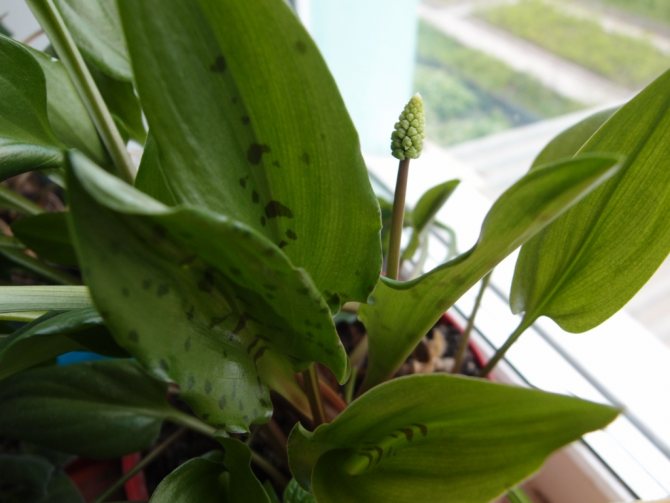
Drimiopsis spotted is also called petiolate ledeburgia. It has a heart-shaped leaf plate, 12 cm long and 5-7 cm wide, with a slightly curved peduncle. The petiole is 15-20 cm long. Flowering begins from mid-spring to mid-summer. It blooms with yellowish-white flowers. During the dormant period, the variegated color disappears on the leaves, then the foliage falls off.


